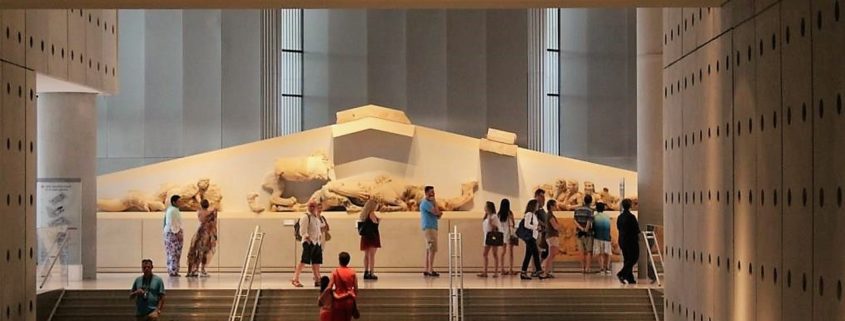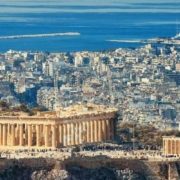A visit to Athens is never complete without a visit to the Acropolis Museum, which first opened its doors in 2009. For all those years, it has been one of the major cultural sightseeing spots of the Greek capital.
The Acropolis; A few words about its history
The monuments on the Acropolis have withstood the test of time: extreme weather conditions, war, explosions, the Parthenon being used as storage space and being dismantled by the Ottoman occupiers, etc…
In addition to this, from the 19th century onwards, foreign visitors to the Acropolis would search through the rubble and take fragments of the sculptures as their souvenirs; the most famous of them being Lord Elgin. He removed intact architectural sculptures from the frieze, the metopes and the pediments of the Parthenon, which are exhibited at the British Museum of London until nowadays.
Take a look at the video below, and watch the Acropolis, as it is now
But Greece also has its famous “Acropolis Museum”!
What most people do not know is that the current museum in Athens is actually the… third Acropolis museum! Who could have guessed? When the Greek State was founded in 1833, discussions about the construction of an Acropolis Museum began. The first museum was built on the Hill of Acropolis, but they quickly realised that there wasn’t sufficient space for the ever-growing number of findings. A second museum, the so-called Little Museum, was built after 1888 as a supplement to the first one but was demolished after the WW II ended.
By the 1970s, the first museum could not cope with the large numbers of visitors and many findings were in storage, unavailable to the public. This is when the idea of a big museum where the Parthenon sculptures would be reunited came back to the table.
After many debates over three decades and various architectural competitions, finally, in 2000, a new international competition was organised and this time there was a winner!
The architects and the architecture
The new Acropolis museum was designed by internationally known Swiss-French architect Bernard Tschumi, in cooperation with Greek architect Michael Photiadis. It covers a total area of 25k square meters, which means it’s about ten times bigger than the old museum.
It overlooks the Hill of Acropolis, engaging in an architectural dialogue with the nearby Parthenon. Instead of trying to mimic Parthenon’s classic style, the museum has a modern style and is entirely free of decorations, so that the emphasis is rather on the ancient sculptures on display. Glass walls allow exhibits to be viewed in natural light, as they would have been seen in ancient times.
Since the Acropolis Museum has a modern design, it was initially a subject of some controversy in Greece, but we believe most visitors now agree it is a piece of art and a big step forward for Greek culture. Nowadays, everybody is amazed by its architecture as well as exhibitions.
The modern entrance lobby has a glass floor, allowing you to peek into the excavation site right underneath the museum and see the outlines of shops, alleys and houses dating back to 600 AD. It literally feels like stepping into a different time and place.
The 3rd floor is a rectangular, glass-enclosed gallery, over 7 meters high and with a floor space of over 2,050 square meters. It offers a 360-degree panoramic view of the Acropolis and contemporary Athens. The Museum is next to the Acropolis Metro Station and its entry is on the Dionysios Areopagitou pedestrian street, which links it to the Acropolis and other key archaeological sites in Athens.
The museum’s permanent exhibition
The museum’s permanent exhibition mirrors the visitor’s ascent to the Hill of Acropolis making us feel like we are indeed climbing to its top to visit the ancient temple.
Starting on the ground floor, we walk through the “Gallery of the Slopes of Acropolis” which consists of findings from the sanctuaries that were located on the slopes of the Acropolis, as well as everyday objects from all historic periods.
The Museum’s exhibition ends on the third floor with the Parthenon Gallery and features a rectangle installation of Parthenon’s frieze, which has the same dimensions as the original. This allows the visitor to walk around and have a closer look at the sculptures and get a better sense of their size in relation to the actual temple.
Casts of the missing sculptures have been used to complete the picture presented from the findings as well as to send a discreet but straightforward message about Greece’s claim on those important sculptures, which till this day are kept in the British museum.
For more info about the museum exhibitions, opening times, tickets, etc…please visit their website at: https://www.theacropolismuseum.gr/en
+++++++++++++++++++++++++++
Interested in learning more about Athens and its museums?
Then download here your FREE TIMELESS ATHENS eBOOK,
and embark on an amazing journey in Athens – Greek Heritage & Modern Charms for Cultural travelers.









